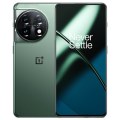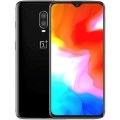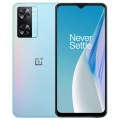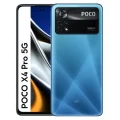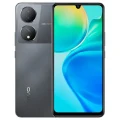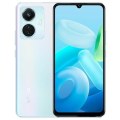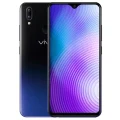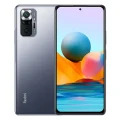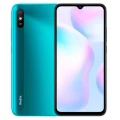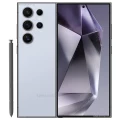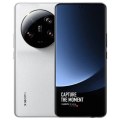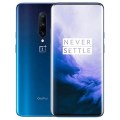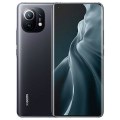- Awesome page
- Latest Mobile
- Smartphones
- OnePlus 8
OnePlus 8
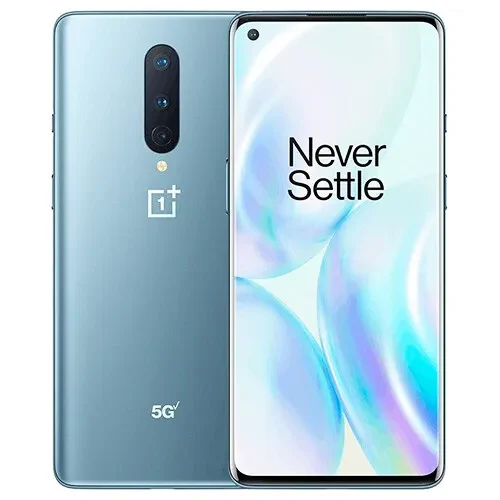


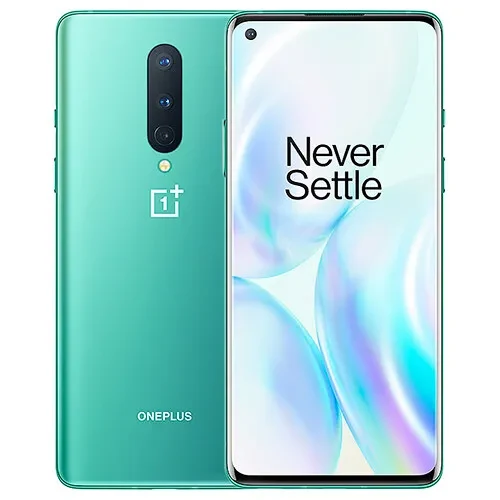
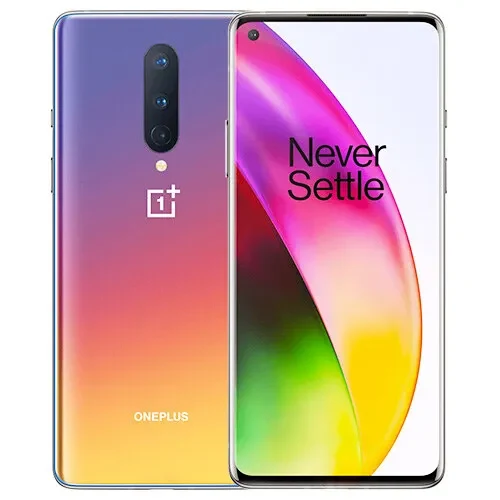
OnePlus 8 Price in Bangladesh
The OnePlus 8 is available for BDT 59,990.The 6.55-inch, 103.6 cm2 (about 88.7% screen-to-body ratio), fluid AMOLED capacitive touchscreen, 16 million color display, and 20:9 ratio (about 402 ppi density) are all features of the OnePlus 8 smartphone.The Qualcomm SM8250 Snapdragon 865 (7 nm+) Octa-core (1×2.84 GHz Kryo 585 & 3×2.42 GHz Kryo 585 & 4×1.8 GHz Kryo 585) CPU powers the OnePlus 8. It contains 128/256 GB of internal storage that cannot be expanded to include external storage, and 8/12 GB of RAM. This fashionable gadget features a 16 MP camera on the front and 48 MP, 8 MP, and 2 MP cameras on the rear. It was run by a conventional 4300 mAh battery.
Specifications
General
| Model | OnePlus 8 |
| Announced | 10-04-2020 |
| Released | 21-04-2020 |
| Status | Available |
| Official price | 8GB 128GB ৳59,990 |
| Unofficial price | 8GB 128GB ৳37,000 / 12GB 256GB ৳42,000 |
Design
| Dimensions | 160.2 x 72.9 x 8 mm (6.31 x 2.87 x 0.31 in) |
| Weight | 180 g (6.35 oz) |
| Colors |
Onyx Black, Glacial Green, Interstellar Glow, Polar Silver |
Network
| Technology | GSM / CDMA / HSPA / LTE / 5G |
| 2G Network |
GSM 850 / 900 / 1800 / 1900 - SIM 1 & SIM 2 CDMA 800 / 1900 & TD-SCDMA |
| 3G Network |
HSDPA 800 / 850 / 900 / 1700(AWS) / 1800 / 1900 / 2100 |
| 4G Network |
LTE band 1(2100), 2(1900), 3(1800), 4(1700/2100), 5(850), 7(2600), 8(900), 12(700), 13(700), 17(700), 18(800), 19(800), 20(800), 25(1900), 26(850), 28(700), 32(1500), 34(2000), 38(2600), 39(1900), 40(2300), 41(2500), 42(3500), 46(5200), 66(1700/2100) - EU LTE band 1(2100), 2(1900), 3(1800), 4(1700/2100), 5(850), 7(2600), 8(900), 12(700), 13(700), 17(700), 18(800), 19(800), 20(800), 25(1900), 26(850), 28(700), 29(700), 30(2300), 34(2000), 38(2600), 39(1900), 40(2300), 41(2500), 46(5200), 48, 66(1700/2100), 71(600) - NA LTE band 1(2100), 2(1900), 3(1800), 4(1700/2100), 5(850), 7(2600), 8(900), 12(700), 17(700), 18(800), 19(800), 20(800), 26(850), 34(2000), 38(2600), 39(1900), 40(2300), 41(2500), 46(5200) - IN LTE band 1(2100), 2(1900), 3(1800), 4(1700/2100), 5(850), 7(2600), 8(900), 12(700), 17(700), 18(800), 19(800), 20(800), 26(850), 34(2000), 38(2600), 39(1900), 40(2300), 41(2500) - CN |
| 5G Network |
5G band 1(2100), 3(1800), 7(2600), 28(700), 78(3500); SA/NSA - EU 5G band 2(1900), 5(850), 41(2500), 66(1700), 71(600); SA/NSA - NA 5G band 78(3500); SA/NSA - IN 5G band 41(2500), 78(3500), 79(4700); SA/NSA - CN mmWave - Verizon exclusive |
| GPRS <strong>GPRS</strong> (General Packet Radio Service) is a packet oriented mobile data service on the 2G and 3G cellular communication system's global system for mobile communications (GSM), Generally, GPRS is used for the purpose of wireless data transfer, such as sharing pictures and videos or browsing the Internet via a mobile phone connection. | |
| EDGE <strong>EDGE</strong> (Enhanced Data GSM Environment) is a wireless network technology generally considered the next step in the 2G network offers data transfer rates up to four times faster than ordinary GSM networks, Generally, EDGE is used for the purpose of wireless data transfer, such as sharing pictures and videos or browsing the Internet via a mobile phone connection. | |
| Speed | HSPA 42.2/5.76 Mbps, LTE-A (5CA) Cat18 1200/150 Mbps, 5G 7.5 Gbps DL |
Display
| Display Type <strong>Display Technology => </strong> A number of display technologies and types used in mobile phones => TFT (Thin Film Transistor), IPS (In-Place Switching), OLED (Organic Light Emitting Diode), AMOLED (Active-Matrix Organic Light-Emitting Diode), Super AMOLED (an even advanced version of AMOLED), Resistive Touchscreen (Resistive touchscreens contain two layer of conductive material with a very small gap between them which acts as a resistance), Capacitive Touchsceen (Capacitive touchscreen technology consists of a layer of glass coated with a transparent conductor) | Fluid AMOLED capacitive touchscreen, 16M colors |
| Size | 6.55 inches, 103.6 cm2 (~88.7% screen-to-body ratio) |
| Resolution | 1080 x 2400 pixels, 20:9 ratio (~402 ppi density) |
| Features |
Protection: Corning Gorilla Glass 6 HDR10+90Hz refresh rate |
Camera
Main camera
| Camera Setup | Triple |
| Primary <strong>Camera</strong> is able to capture photographs and usually videos, The most important characteristics of a camera are the resolution (measured in megapixels), lens focus type (fixed or automatic), higher megapixel cameras are known to capture higher quality photos, but not always a good measurement of the photos quality. |
48 MP, f/1.8, 25mm (wide), 1/2.0&quot;, 0.8µm, PDAF, OIS 16 MP, f/2.2, 13mm (ultrawide), PDAF 2 MP, f/2.4, (macro) |
| Features |
Dual-LED flash, HDR, panorama |
| Video | 2160p@30/60fps, 1080p@30/60/240fps, 720p@960fps, Auto HDR, gyro-EIS |
Selfie camera
| Camera Setup | Single |
| Primary <strong>Camera</strong> is able to capture photographs and usually videos, The most important characteristics of a camera are the resolution (measured in megapixels), lens focus type (fixed or automatic), higher megapixel cameras are known to capture higher quality photos, but not always a good measurement of the photos quality. |
16 MP, f/2.0, (wide), 1/3&quot;, 1.0µm |
| Features |
Auto-HDR |
| Video | 1080p@30fps, gyro-EIS |
Hardware
Connectivity
| Bluetooth <strong>Bluetooth</strong> is a wireless communications technology for exchanging data between mobile phones, headsets, computers and other network devices over short distances without wires, Bluetooth technology was primarily designed to support simple wireless networking of personal consumer devices. | 5.0, A2DP, LE, aptX HD |
| Infrared <strong>Infrared</strong> connectivity is an old wireless technology used to connect two electronic devices. It uses a beam of infrared light to transmit information and so requires direct line of sight and operates only at close range. | |
| USB | 3.1, Type-C 1.0 reversible connector, USB On-The-Go |
| GPS <strong>GPS</strong> The Global Positioning System is a satellite-based radio navigation system, GPS permits users to determine their position, velocity and the time 24 hours a day, in all weather, anywhere in the world, In order to locate your position, your device or GPS receiver must have a clear view of the sky. | Yes, with dual-band A-GPS, GLONASS, BDS, GALILEO |
| NFC <strong>NFC</strong> (Near field communication) is a set of standards for smartphones and similar devices to establish peer-to-peer radio communications with each other by touching them together or bringing them into proximity, usually no more than a few inches. |
Battery
| Battery Type <strong>Battery Type => </strong> Cell phones run on various kinds of batteries depending on the manufacturer, phone size or shape and features. There are basically four types of cell phone batteries => Lithium Polymer, Lithium Ion, Nickel Metal Hydride and Nickel Cadmium. | Non-Removable Li-Po |
| Capacity <strong>Battery Capacity</strong> is a measure (typically in Amp-hr) of the charge stored by the battery, and is determined by the mass of active material contained in the battery. The battery capacity represents the maximum amount of energy that can be extracted from the battery under certain conditions. | 4300 mAh |
OnePlus 8 Review: The Flagship Killer Redefined
When it comes to smartphones that offer premium features without breaking the bank, OnePlus has been a game-changer. The OnePlus 8 is no exception. In this comprehensive review, we’ll delve deep into what makes the OnePlus 8 a standout in the crowded smartphone market. From its stunning design to its robust performance, we’ll cover everything you need to know. Whether you’re a tech enthusiast, a gadget lover, or simply someone looking for a new smartphone, this blog post is for you.
Introduction
The OnePlus 8 has been one of the most anticipated releases of the year, and for good reason. This smartphone aims to deliver high-end features at a price point that’s more accessible than other flagships. With its sleek design, powerful hardware, and versatile camera system, the OnePlus 8 promises a lot. But does it live up to the hype? In this review, we’ll explore its design, performance, camera capabilities, battery life, and much more. By the end, you’ll have a clear understanding of whether the OnePlus 8 is the right smartphone for you.
Design and Display
One of the first things you’ll notice about the OnePlus 8 is its striking design. The phone features a slim profile with curved edges, making it comfortable to hold. The build quality is top-notch, thanks to its Gorilla Glass front and back, coupled with an aluminum frame. This not only adds to its aesthetic appeal but also ensures durability.
The display is another highlight of the OnePlus 8. Sporting a 6.55-inch Fluid AMOLED screen with a resolution of 2400 x 1080 pixels, the visuals are crisp and vibrant. The 90Hz refresh rate offers a smooth scrolling experience, making everything from browsing to gaming feel more fluid. HDR10+ support ensures that colors are more dynamic, perfect for watching videos and playing games. Unique design elements like the punch-hole front camera and minimal bezels add to the device’s modern look.
Performance and Hardware
Under the hood, the OnePlus 8 is a beast. Powered by the Qualcomm Snapdragon 865 processor, it delivers fast and efficient performance. Whether you’re multitasking, gaming, or streaming, the OnePlus 8 handles it all with ease. The device comes with either 8GB or 12GB of RAM, ensuring that you can switch between apps without any lag.
The storage options include 128GB and 256GB UFS 3.0, providing ample space for your apps, photos, and videos. One of the standout features is its 5G connectivity, making it future-proof as networks continue to roll out. However, one downside is the lack of expandable storage. Despite this, the hardware package is impressive, making the OnePlus 8 a strong contender in its price range.
Camera Capabilities
The OnePlus 8 features a versatile camera setup that includes a 48MP main sensor, a 16MP ultra-wide lens, and a 2MP macro lens. The main sensor captures excellent detail and dynamic range, producing high-quality images in various lighting conditions. The ultra-wide lens is perfect for landscape shots, while the macro lens allows for close-up photography.
Image quality is one of the OnePlus 8’s strengths. Photos are sharp with accurate colors, and the Nightscape mode enhances low-light photography, making even nighttime shots look impressive. The 16MP front-facing camera also performs well, capturing detailed selfies with good color reproduction. Additional features like portrait mode, super slow motion, and 4K video recording add to the camera’s versatility.
Battery Life and Charging
Battery life is crucial for any smartphone, and the OnePlus 8 doesn’t disappoint. Equipped with a 4,300mAh battery, it easily lasts a full day under normal usage conditions. Whether you’re browsing, streaming, or gaming, you can rely on the OnePlus 8 to keep up.
Charging capabilities are another area where the OnePlus 8 shines. The Warp Charge 30T technology allows for fast charging, getting you from 0 to 50% in just about 22 minutes. Unfortunately, there’s no wireless charging option, which might be a deal-breaker for some. However, the fast wired charging compensates for it to some extent. Battery optimization features like adaptive battery and power-saving modes further enhance the overall battery performance.
Software and User Interface
The OnePlus 8 runs on OxygenOS, based on Android 10. OxygenOS is known for its clean, user-friendly interface and offers a near-stock Android experience with additional customization options. The software is smooth, responsive, and free from bloatware, making it a pleasure to use.
Unique software features like Zen Mode, which encourages you to take a break from your phone, add value to the user experience. Customization options allow you to tweak everything from the home screen layout to accent colors, ensuring that the phone feels truly yours. Overall, the software experience on the OnePlus 8 is one of its strongest points.
Connectivity and Audio
When it comes to connectivity, the OnePlus 8 is well-equipped. It supports Wi-Fi 6, Bluetooth 5.1, NFC, and, of course, 5G. These features ensure that you’re well-connected, whether you’re at home, in the office, or on the go. The call quality is excellent, with clear audio and strong network reception.
The audio capabilities are also noteworthy. The OnePlus 8 features stereo speakers that deliver loud and clear sound, making it great for media consumption. However, there is no headphone jack, which means you’ll need to use wireless earbuds or a USB-C adapter. Despite this, the overall audio experience is satisfying, thanks to Dolby Atmos support.
Pricing and Value for Money
One of the most compelling aspects of the OnePlus 8 is its pricing. Starting at $699 for the base model, it offers a lot of bang for your buck. Given the features and performance it packs, the OnePlus 8 provides excellent value for money.
When compared to other smartphones in a similar price range, the OnePlus 8 holds its own. Competitors like the Samsung Galaxy S20 and the iPhone 11 Pro offer similar features but come at a higher price. The OnePlus 8 strikes a balance between premium features and affordability, making it a smart choice for budget-conscious consumers who don’t want to compromise on quality.
Pros and Cons
Every device has its strengths and weaknesses, and the OnePlus 8 is no exception. Let’s summarize the main advantages and limitations of this smartphone.
Pros:
- Design and Display: Sleek design, high-quality materials, and a vibrant 90Hz AMOLED display.
- Performance: Robust hardware with a Snapdragon 865 processor and up to 12GB of RAM.
- Camera: Versatile camera setup with excellent image quality.
- Battery Life: Long-lasting battery with fast Warp Charge 30T technology.
- Software: Clean, customizable OxygenOS based on Android 10.
Cons:
- No Expandable Storage: Limited to internal storage options.
- No Wireless Charging: Lacks the convenience of wireless charging.
- No Headphone Jack: Requires wireless earbuds or a USB-C adapter for audio.
Conclusion
The OnePlus 8 is a testament to how far smartphones have come in terms of blending performance, design, and affordability. It offers a premium experience without the premium price tag, making it an excellent choice for tech enthusiasts, gadget lovers, and anyone in the market for a new smartphone. With its sleek design, powerful performance, versatile camera, and long battery life, the OnePlus 8 stands out as a flagship killer redefined.
If you’re considering upgrading your smartphone, the OnePlus 8 is definitely worth a look. Its combination of high-end features and competitive pricing makes it a compelling option in today’s crowded smartphone market. So why wait? Explore the OnePlus 8 and experience the future of smartphones today.
